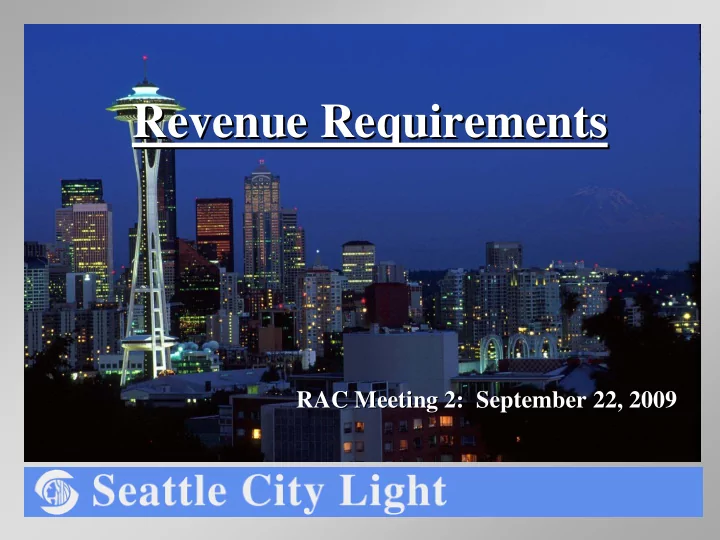

Revenue Requirements Revenue Requirements RAC Meeting 2: September 22, 2009 RAC Meeting 2: September 22, 2009
City Light Vision To set the standard and deliver the best customer service experience of any utility in the nation 2
City Light’s Long-Term Strategic Priorities � Recruit, support and promote high performance team – Aging Workforce � Protect and enhance the environment – Additional focus on GHG � Strengthen and improve energy delivery infrastructure – Asset Management; Outage Management; Smart Grid � Develop an efficient power resource portfolio – Renewables and Energy Conservation � Ensure financial resilience – Risk Management; Financial planning for this rate adjustment process 3
Three Steps to Rate Making Step 1: Revenue Requirements Analysis The analysis of the revenues required to meet City Light operating and maintenance expenses, and to finance a portion of the City Light Capital Improvement Program consistent with financial policies. 4
Achieving a Careful Balance Rates that Providing are for the responsive financial to health of customer needs the utility 5
Current Financial Policies � Debt service coverage of 2.0 (allows $ for capital) � 95% confidence of at least $1 of cash from operations towards capital � 95% confidence of sufficient supply to serve load � Debt to capitalization target of 60% end of 2010 � Cash balances – $30M monthly – $25M Contingency Reserve City Council Resolution 30761: May 2005 City Council Resolution 30761: May 2005 6
Effectiveness of Current Policies � The financial policies currently in place have been the foundation for the utilities financial recovery from the energy crisis earlier in the decade. � They paved the way to reducing debt and increasing the bond ratings – reducing risk and cost. � As demonstrated by the current financial crisis, the current policies do not address all the major risks – Wholesale Power Revenue volatility is still a major risk. 7
SCL Budget - 2010 Endorsed Sources of Revenue, Total = $1089.9M Residental, $188.1, 17% Other, $359.0 33% Commercial & Industrial, $347.1 Wholesale, $195.7 32% 18% Uses of Revenue (Budget), Total = $1089.9M CIP andConservation, $196.2, 18% Purchased Power, $408.3, 37% O&M and General Expense, $267.4, 25% Debt Service and Taxes, $217.9, 20% 8
Financial Forecast vs Budget � Forecast does not equal Budget. Why? – Purchased power higher in budget – Conservation deferred in forecast – A&G capitalized assumed in forecast – CIP planned vs allowed, carryovers to next year – Budget covers expected debt service (not twice) – Pattern of cash outlays different Rates are determined by the financial forecast Rates are determined by the financial forecast 9
Financial Forecast (handout) Operating cash in minus operating cash out = Cash available for debt service - Cash to City taxes & debt service = Cash from Operations + Cash from contributions and bond proceeds = Cash to capital investment and deferred O&M Cash in = Cash out on a planning basis Cash in = Cash out on a planning basis 10
Differences: 2007/2008 Plan vs 2010 Plan (handout) Cash from current retail rates and expected load + Cash from wholesale power sales (net) + Cash from other sources - Cash to power contracts - Cash to operations - Cash required for debt service coverage = GAP Cash in and cash out have changed since rates were last set Cash in and cash out have changed since rates were last set 11
+ $61M Operating Expenses (handout) Production $11 Transmission 3 Distribution 23 Conservation 6 Customer Accounting 5 Administration 13 TOTAL $61 These are the most “controllable” of SCL’s expenses These are the most “controllable” of SCL’s expenses 12
How can the gap be closed? � Change financial policies � Reduce expenses � Increase rate revenues � Increase cash from other sources Decisions can be made around these options Decisions can be made around these options 13
Recommend
More recommend